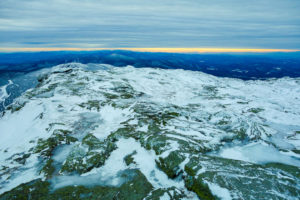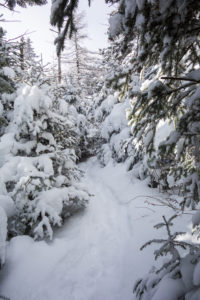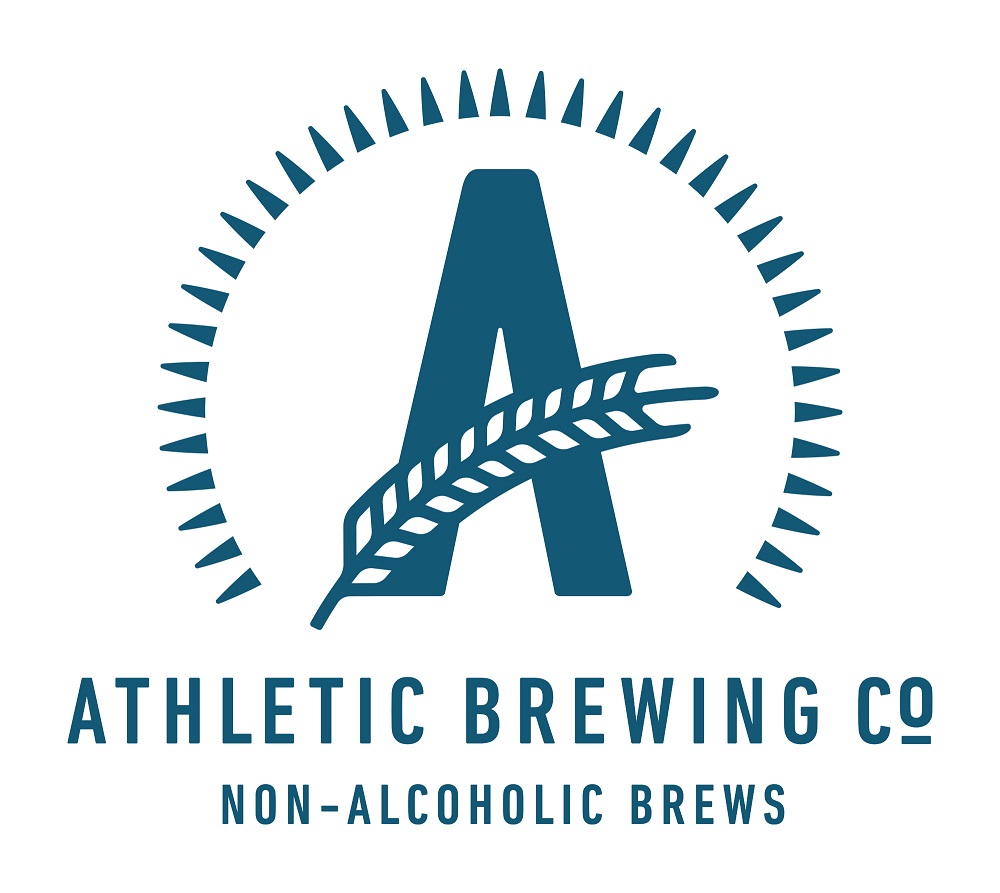This post was written by Caitlin Miller, GMC’s Group Outreach and Administrative Assistant and former Caretaker and Southern Field Assistant.
Plan Ahead and Prepare
 Now that you’ve geared up with layers and MICROspikes, let’s talk about staying safe. Planning ahead is, once again, the best way to be safe on the trail. Besides the actual hiking and incredible scenery, I love winter hiking because of all the delicious snacks I bring for my hikes. Although it sounds like common sense, staying well-fed and well-hydrated are perhaps the two most important things you can do to stay safe while winter hiking (or, really, when hiking anytime during the year). When you’re hiking, especially during the winter, your body is going into overtime to regulate your temperature. When you’re barreling along at a cool 2 mph, your body is going to crank out sweat and heat to keep you cool. However, unlike in summer when your body continues to cool itself when you stop, in winter when you stop for a break your body must shift much faster into warming mode. I’ve stopped many times on my way up a mountain in just my base-layer and, despite steam rising off my skin, I’ll start shivering immediately when the wind hits my sweat-soaked shirt. This constant battle for homeostasis burns a lot of calories and a lot of water. Add in some postholing and breaking trail and you’re probably burning over 3,000 calories for a 6-hour hike.
Now that you’ve geared up with layers and MICROspikes, let’s talk about staying safe. Planning ahead is, once again, the best way to be safe on the trail. Besides the actual hiking and incredible scenery, I love winter hiking because of all the delicious snacks I bring for my hikes. Although it sounds like common sense, staying well-fed and well-hydrated are perhaps the two most important things you can do to stay safe while winter hiking (or, really, when hiking anytime during the year). When you’re hiking, especially during the winter, your body is going into overtime to regulate your temperature. When you’re barreling along at a cool 2 mph, your body is going to crank out sweat and heat to keep you cool. However, unlike in summer when your body continues to cool itself when you stop, in winter when you stop for a break your body must shift much faster into warming mode. I’ve stopped many times on my way up a mountain in just my base-layer and, despite steam rising off my skin, I’ll start shivering immediately when the wind hits my sweat-soaked shirt. This constant battle for homeostasis burns a lot of calories and a lot of water. Add in some postholing and breaking trail and you’re probably burning over 3,000 calories for a 6-hour hike.
Since your body’s doing all this incredible work for you, it’s nice to keep it fed and watered. Bring plenty of snacks, a lunch, even more snacks, and at least 2 liters of water depending on how long you’ll be out. I also like to help along my body’s attempts at warming up by bringing a thermos of hot chocolate or super sweet coffee. Much like a furnace, your body needs fuel. No matter how many jackets you put on a cold furnace, it will never warm up because it does not have any fuel to create heat. The hot chocolate (or coffee; think melted coffee ice cream) is full of simple sugars that are easy for your body to metabolize. Your body can quickly use those sugars to warm you up. Check out this recipe from The Minimalist Baker for a sugar and protein-packed trail snack. Fuel your body’s furnace!
I firmly believe that when you’re hiking, food fixes almost any problem. Hungry? Eat. Cold? Eat. Tired? Eat. Frustrated? Eat. Sad? Eat. Clumsy? Eat. I’m sure you’ve heard of the term “hangry” – that is, when someone gets hungry they also start to get angry and short-tempered. Being hangry can be inconvenient in the front country, but in the backcountry letting your blood sugar get too low can be very serious. Not only are you more prone to slips and falls, but your judgment also becomes impaired. Someone who is dehydrated and hungry is a lot more likely to push on when they shouldn’t or leave behind an important piece of gear.
Hypothermia
 One of the biggest dangers posed to someone who is not properly fed and hydrated while hiking is hypothermia. Per the Mayo Clinic:
One of the biggest dangers posed to someone who is not properly fed and hydrated while hiking is hypothermia. Per the Mayo Clinic:
“Hypothermia is a medical emergency that occurs when your body loses heat faster than it can produce heat, causing a dangerously low body temperature. Normal body temperature is around 98.6 F (37 C). Hypothermia occurs as your body temperature passes below 95 F (35 C).”
If you’re not giving your body the proper nutrition and water intake, hypothermia is much more likely to occur because your body is not capable of maintaining homeostasis in the face of freezing temperatures. Hypothermia is also scary because it affects your reasoning and judgment first. We often hear about crazy circumstances related to hypothermia deaths, such as the victim being found in only a t-shirt when they had a full pack with a tent and sleeping bag just a few yards away. When you’re hypothermic it is almost impossible to think properly since your brain is devoting what little energy it has to necessary functions such as breathing and heart rate.
So yes, hypothermia is a scary and serious condition. However, it is also very preventable and, at the beginning stages, easy to reverse. So, how do you tell if someone in your hiking group is mildly hypothermic? One tool I use is called The Umbles: the mumbles, stumbles, and grumbles. If someone in your group is tripping frequently, slurring their words or mumbling, and generally being a pain in the butt when they’re usually a ray of sunshine, they are probably too cold. Shivering uncontrollably and blue lips are also early signs of hypothermia. It is important that you act quickly:
- Get them out of any wet clothes and put them in warm, DRY clothes. They will NOT get warm if you just put dry layers over their wet clothes. Do this even if it means temporarily exposing their bare skin.
- Fuel their furnace! Feed them a sugary snack or some of that delicious hot cocoa you packed along.
- Keep them moving. Don’t let them sit still, especially not on the cold ground. Hop around with them, do jumping jacks, dance; anything to keep them moving. Although I normally hate when people bring speakers with them hiking, I fully condone it if the speakers are used for anti-hypothermia dance parties.
Most people will quickly begin to feel better with this simple treatment. Unfortunately, hypothermia is much harder to catch if you are by yourself. I’ve found that if I keep pushing on even if I’m tired, cold, or thirsty (often with the reasoning “Just 10 more minutes” or “I’m almost to the trail junction”), I absolutely need to force myself to stop and do the steps above. Before I know it, I’m feeling fine again and can continue safely. If someone is not getting warmer or they are already extremely incoherent and belligerent, you need to get them inside as quickly as possible.
Frostbite
Frostbite is a condition that can go hand in hand with hypothermia, or it can happen on its own. Whereas hypothermia is concerned with your core body temperature, frostbite is the freezing of exposed skin and most often occurs in the extremities. I can’t even count the number of times I’ve been out and suddenly realized “Hey, my nose is numb!” I was experiencing early frostbite. Along with numbness, you can also tell if someone is getting frostbite because the affected area turns white and begins to harden. At this stage, it is crucial to cover the exposed skin and try to warm it up. The later stages of frostbite include blebs (large blisters) and dark coloration. If someone experiences either of these symptoms, they must be brought to the hospital as soon as possible and, whatever you do, DO NOT try to thaw or warm those areas on your own. It will be extremely painful and can lead to the death of the extremity. I’m cringing just thinking about it.
First Aid
Phew! Now that we’ve covered the scary conditions, here is an example list of what I keep in my first aid kit when I head out in the winter:
- Band-Aids
- Emergency blanket
- Alcohol wipes
- Duct tape
- Ibuprofen
- Moleskin
- Clothespins
- ACE bandage
- Sewing needle & thread
- Gatorade pack/candy bar
- Whistle
- Waterproof matches
- Personal medication
- Hand and toe warmers
- Chapstick
If you want to learn more about how to treat hypothermia, frostbite, or even sprains, broken ankles, heavy bleeding wounds, learn about search and rescue protocol, and so much more, please check out our upcoming Wilderness First Aid course. Not only is the course fascinating, but you’ll finish it WFA certified and ready for almost anything that comes your way in the woods.
Winter hiking is a special rite of passage for the hardy folks of Vermont. As long as you take good care of yourself, the adventure possibilities in this gorgeous state are endless!



















Very interesting advices. I did alot of winter hiking in the past and I’m planning to do it again this year. Thank you
In your opinion, what’s the best jacket for winter trailing?